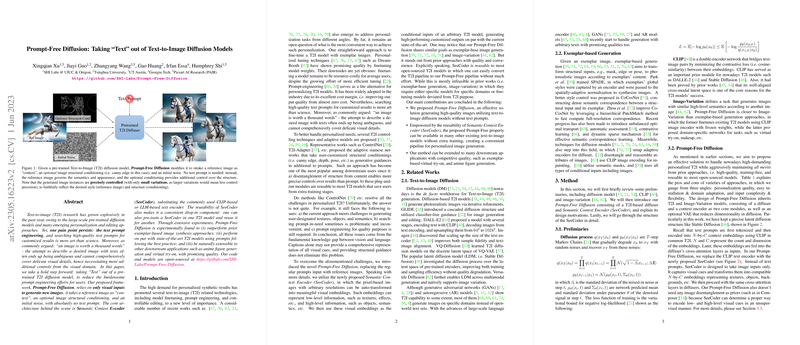An Analysis of "Prompt-Free Diffusion: Taking 'Text' out of Text-to-Image Diffusion Models"
The paper "Prompt-Free Diffusion: Taking 'Text' out of Text-to-Image Diffusion Models" presents a novel approach to image synthesis by removing the requirement for text prompts in Text-to-Image (T2I) diffusion models. The authors introduce a framework that utilizes visual inputs, termed as Prompt-Free Diffusion, which allows the generation of customized images without the burdensome task of prompt engineering.
Core Contributions
The primary innovation is the Semantic Context Encoder (SeeCoder), which replaces traditional text encoders like CLIP within T2I models. This advancement facilitates the encoding of an image's visual cues into embeddings which are then used to govern the image generation process. Key contributions of the paper include:
- Prompt-Free Generation: The authors successfully eliminate the need for text prompts by substituting with reference images, enabling more direct and intuitive control over the generated content.
- Reusability of SeeCoder: SeeCoder can be pre-trained in one context and then employed across various T2I models without the need for further retraining, enhancing versatility and saving computational resources.
- Application Range: The framework extends to downstream applications like anime figure generation and virtual try-on, demonstrating its adaptability across domains.
Methodological Details
The authors utilize a latent diffusion model architecture akin to Stable Diffusion, where SeeCoder takes the place of a conventional CLIP text encoder. The encoder effectively transforms reference images into embeddings that capture both high-level semantics and low-level visual details. These embeddings provide the conditional inputs necessary for the diffusion model to generate high-quality, coherent outputs.
The SeeCoder comprises a backbone encoder, decoder, and query transformer. The backbone captures multi-resolution features, while the decoder processes these features into a comprehensible form for the query transformer, which extracts and constructs the final visual embedding.
Experimental Evaluation
The paper reports that the proposed Prompt-Free Diffusion outperforms prior exemplar-based image synthesis approaches and matches the quality of state-of-the-art models that rely on text prompts. Specifically, it demonstrates strong alignment in image variation tasks, surpassing models like Versatile Diffusion (VD) under comparable conditions.
Additionally, the research explores the framework's applicability in virtual try-on and anime figure generation, showcasing competitive outputs without additional training requirements for SeeCoder. The adaptability of SeeCoder across various T2I models further underscores its potential for broad applicability within the field.
Implications and Future Directions
This research addresses the challenges associated with prompt engineering in T2I models, offering a more intuitive method of image synthesis that leverages the expressiveness of visual inputs. The implications are significant for industries requiring streamlined and efficient design processes.
In terms of future developments, the model's efficacy could be further enhanced by incorporating advanced control mechanisms or exploring its integration into video generation tasks. The inherent flexibility of SeeCoder augurs well for continued research and potential application in multimodal AI systems.
Ethical Considerations
The authors also address the ethical dimensions associated with image generation technologies, acknowledging potential biases and the necessity for responsible deployment. Emphasizing ethical guidelines and transparency in model usage is vital to mitigating any negative societal impacts.
In conclusion, "Prompt-Free Diffusion" presents a promising advancement in the field of image synthesis, offering nuanced control through visual inputs devoid of textual dependency. The potential for scalability and integration into existing pipelines marks it as a significant contribution to the field of AI and creative technologies.
